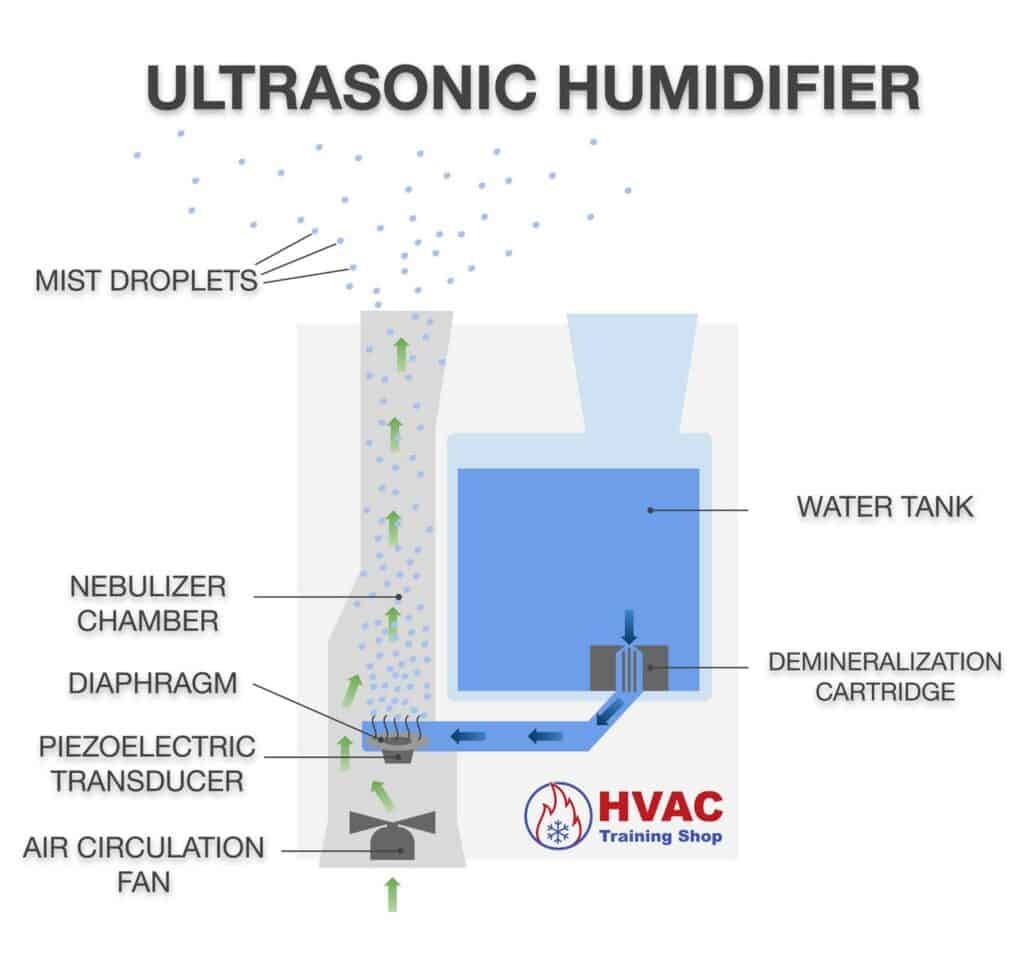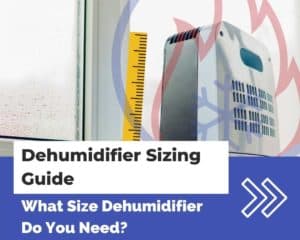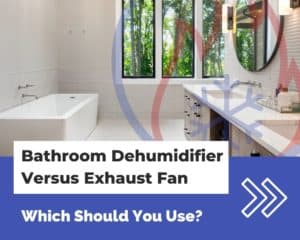HVAC Training Shop is reader-supported. As an Amazon Associate, I earn from qualifying purchases.
When trying to maintain a certain humidity level in your home, you can use either a humidifier or a dehumidifier. But which one should you use?
Depending on the situation, it is more appropriate to use one versus the other. Humidifiers and dehumidifiers also work in completely different ways.
The difference between a humidifier and a dehumidifier is that a humidifier adds moisture to the air in your room, while a dehumidifier removes moisture.
In this article, I’ll go over the differences between humidifiers and dehumidifiers. I’ll also discuss the different types of humidifiers and dehumidifiers, and which one is best for your situation.
What’s the difference between a humidifier and a dehumidifier?
Humidifiers add moisture to the air. Humidifiers are used when the air in a space is too dry.
Dehumidifiers remove moisture from the air. Dehumidifiers are used when the air in a space is too humid.
Humidifier versus dehumidifier: Which one should you use?
You should use a humidifier when you need more moisture in the air in your room. If the air is too dry in your room, then a humidifier will help with that.
You should use a dehumidifier when you need to dry out the air in your room. Or if there is an excessive amount of moisture in the air in your room.
Depending on the humidity in your space, it may be more appropriate to use a humidifier or a dehumidifier.
If the humidity in your home is below 30%, you should use a humidifier.
If the humidity in your home is above 60%, you should use a dehumidifier.
To measure the humidity level in your home, I recommend using a hygrometer.
Large screen equals easy measurement of room humidity and temperature levels. Features include comfort indicator, max/min records, and °C/°F switching.
Generally speaking, you should use a humidifier if:
- Your skin, eyes, or throat is dry
- Your houseplants are drying out
- Your wooden furniture is drying out
- There is static electricity in your home
Generally speaking, you should use a dehumidifier if:
- Your room has a musty smell
- Your room has mold or mildew growing on surfaces
- Your had a water leak inside your home, so you’re trying to dry it out
- Your basement or laundry room is damp
For more information, check out my article on home humidity levels below:
Types of humidifiers
There are two main types of humidifiers:
- Warm-mist humidifiers generate humidity by heating up water to make steam.
- Cool-mist humidifiers generate humidity by evaporation or vibrations.
I’ll discuss how both types of humidifiers work below.
Warm-mist humidifiers
Warm-mist humidifiers have a heating element inside of them. The heating element is submerged in a reservoir full of water. When the heating element gets hot, the water turns to steam and flows into the air in your room.
Although most warm-mist humidifiers are safe to touch, a warm-mist humidifier still poses a burn hazard if handled improperly. Because of this, warm-mist humidifiers are not recommended if you have children or pets.
One benefit of warm-mist humidifiers is that they are more sanitary than their cool-mist counterparts. When the water in a warm-mist humidifier boils, bacteria and other pathogens are killed. This ensures that the moisture that goes into your room is clean.
Warm-mist humidifiers will also slightly heat up your room’s air. This is a desirable effect during the cold winter months—when you need to heat your home anyway.
However, if you need a humidifier when the weather is hot, then a warm-mist humidifier is not the best option. Consider getting a cool-mist humidifier instead.
Cool-mist humidifiers
There are many different types of cool-mist humidifiers, and they all work in different ways:
- Ultrasonic humidifiers produce humidity by a diaphragm that vibrates at ultrasonic speeds. The diaphragm shakes the water to create fine mist droplets that are blown into your room by a fan. As the mist droplets evaporate, humidity is added to your room.
- Evaporative humidifiers produce humidity by blowing air across a wick. The wick is dipped into a reservoir of water, so it is always wet. As air is blown across the wick, humidity is added to the air in your room.
- Impeller humidifiers produce humidity by a rotating disc that flings water droplets into a diffuser. The diffuser will then further break down the water droplets into a fine mist that is blown into your room. As the mist particles evaporate, humidity is added to your room.
The good thing about cool-mist humidifiers is that they are safe to use around children and pets. There is no risk of burning from a cool-mist humidifier since they don’t generate heat.
Cool-mist humidifiers also don’t heat up the air in your room. So if you need to humidify your room in the summertime, they are a great option.
One drawback of using a cool-mist humidifier is that it creates fine mist droplets. These droplets may fall out of the air before becoming absorbed. This means that your floor and furniture around the cool-mist humidifier may become slightly damp in some areas.
Another drawback of using a cool-mist humidifier is that they are susceptible to producing white “humidifier dust”. Humidifier dust is composed of minerals that were dissolved in the water.
One way to get rid of humidifier dust is to only use distilled water in your humidifier. Distilled water is made up of pure water—it does not have any dissolved minerals inside of it.
Types of dehumidifiers
There are two main types of dehumidifiers:
- Compressor dehumidifiers
- Desiccant dehumidifiers
There are also ventilating dehumidifiers, which I’ll talk about as well.
Compressor dehumidifiers
Compressor dehumidifiers remove moisture by means of a refrigeration cycle, just like air conditioning equipment does. Compressor dehumidifiers subcool the air in your room so that moisture condenses out of the air. Then the air is reheated back to dry, room temperature air.
Compressor dehumidifiers are the most common type of dehumidifier. If you have ever seen a dehumidifier in someone’s home, there is a good chance that it was a compressor dehumidifier.
The main drawback of using a compressor dehumidifier is that it is ineffective at removing humidity when the temperature is below 60°F.
Compressor dehumidifiers are also susceptible to icing up when the temperature is too low. Compressor dehumidifiers also ice up if they are not cleaned regularly.
Desiccant dehumidifiers
Desiccant dehumidifiers remove moisture by using a desiccant wheel. The desiccant wheel traps moisture when air flows through it.
After the wheel traps moisture, the moisture needs to be removed from the wheel. This is done via one of two ways:
- Reactivation by exhaust air. The dehumidifier sucks in air, heats it up, then blows it through the desiccant wheel.
As the hot reactivation air flows through the desiccant wheel, the air removes the moisture from the desiccant wheel. This process “reactivates” the desiccant wheel and gets the wheel ready to pull moisture out of the air again. - Reactivation by circulated air. The dehumidifier sucks in air from the room, heats it up, then blows it through the desiccant wheel.
After the moisture is removed from the desiccant wheel, the air flows through a cool condenser coil. As the air flows through the condenser coil, moisture condenses out of the reactivation air.
The moisture is stored in a collection tank to be removed manually by emptying, or by pumping out.
The main advantage of desiccant dehumidifiers is that they are able to dehumidify the air to a much lower level of humidity.
Compressor dehumidifiers can only dehumidify the air to around 30%RH effectively. Desiccant dehumidifiers can dehumidify the air lower than that—0%RH in some cases.
Another advantage of using desiccant dehumidifiers is that they work in cold temperatures. Most desiccant dehumidifiers can work when the air gets down to freezing temperatures, around 32°F.
The main drawback of desiccant dehumidifiers is that they are expensive and complicated. Desiccant dehumidifiers are more of a specialized piece of equipment that you use when you need to maintain a humidity level under specific conditions.
You’ll almost always be better off using a compressor dehumidifier in your home since they are cheap, simple, and will give you fewer problems in the long run.
Ventilating dehumidifiers
The advantage of using a ventilating dehumidifier is that in addition to dehumidification, it also provides fresh outside air to your home.
Don’t be confused—the “ventilating” part only refers to the fact that the ventilating dehumidifier also provides outside ventilation air to your home. Ventilating dehumidifiers can be either a compressor dehumidifier or desiccant dehumidifier.
For most residential applications, ventilating dehumidifiers are compressor dehumidifiers. You’ll only find ventilating desiccant dehumidifiers in large buildings.





